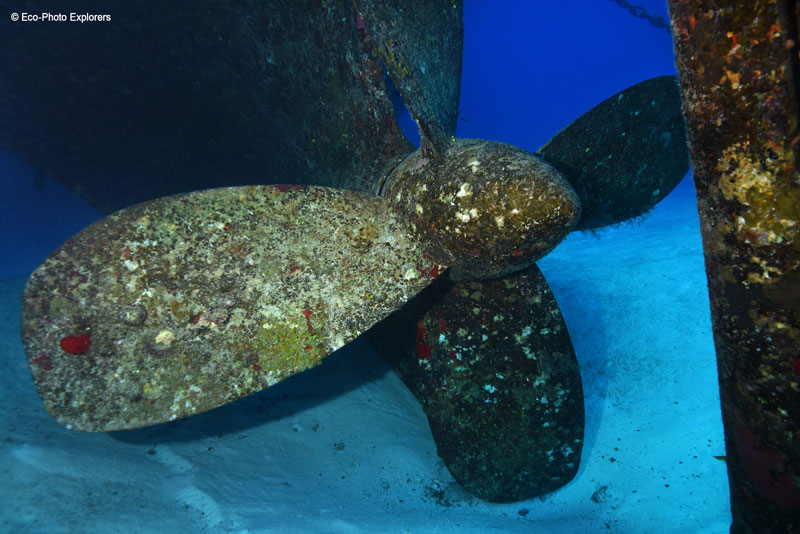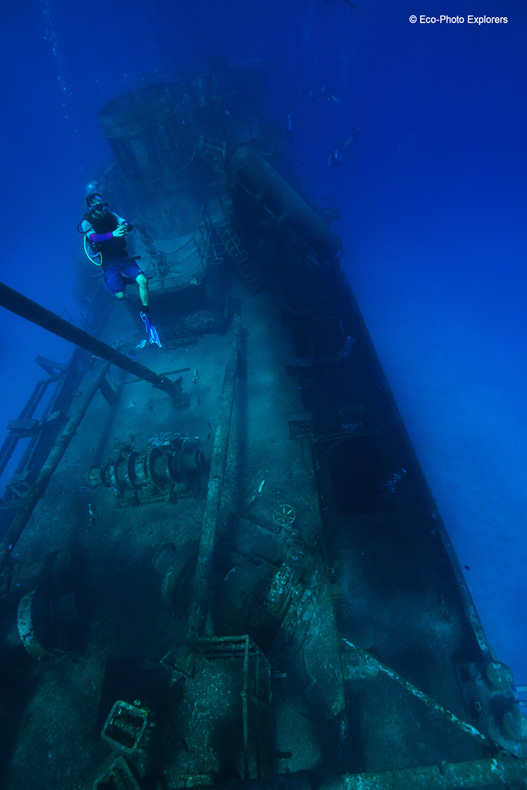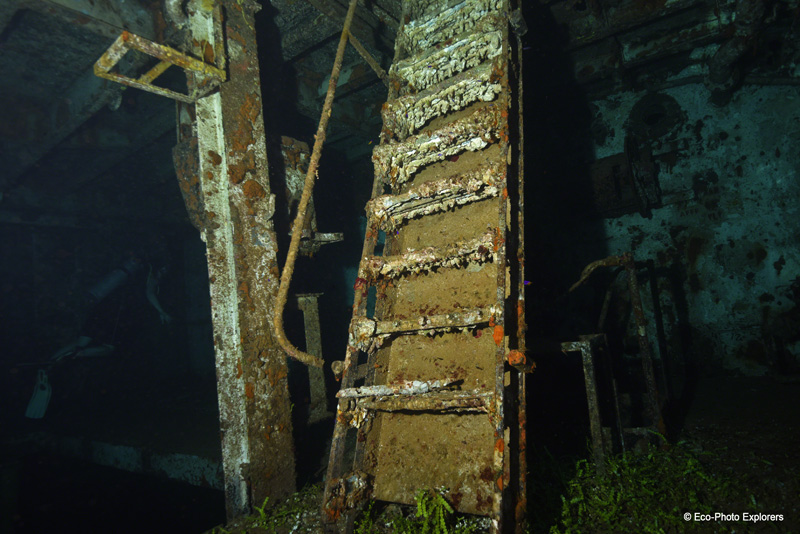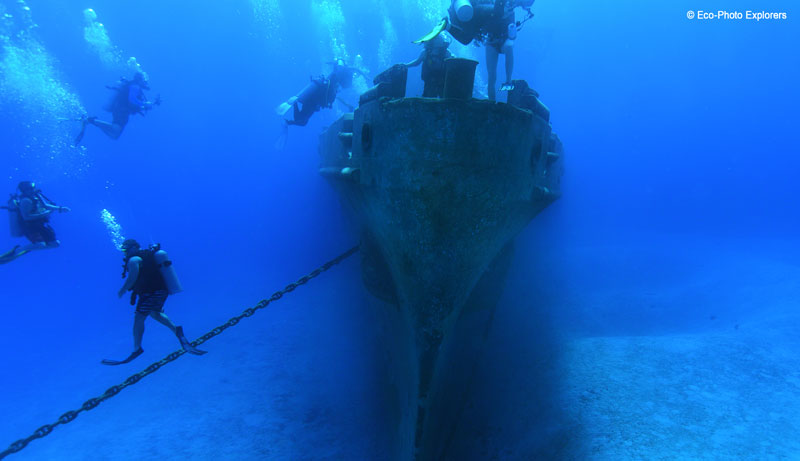It took a while to sink the USS Kittiwake. Ten years, and twenty minutes in fact. But on January 5, 2011, the USS Kittiwake (ASR-13), a chanticleer-class submarine rescue vessel that was launched on July 10, 1945 and decommissioned on September 30, 1994, began the next phase of her long and distinguished career as an artificial reef off the northern end of Seven Mile Beach on Grand Cayman Island. On that day, after three long hours of waiting in the warm Caribbean sun after the process of sinking the ship started, the hull finally began to fill with water and the throngs of onlookers began to cheer loudly as the ship slowly dipped beneath the clear, blue waters of Grand Cayman. The stern sank first, followed by a foamy burst of bubbles as the rest of the ship quickly disappeared from view. A new dive site had been created, one that was immediately popular and that continues to receive scores of divers each week to this day.
Divers who visit the Kittiwake today find a mesmerizing wreck sitting upright on a white, sandy bottom only a short boat ride from the resorts along Seven Mile Beach. The ship is resting in 62 feet of water, making her an ideal spot for divers of all certification levels. The top of the wreck is within seven feet of the surface, and can be enjoyed by snorkelers and divers alike.
Words & Photos by Michael Salvarezza and Christopher P. Weaver
It is a terrific wreck for divers wishing to explore its photogenic superstructure and its many exciting passageways. Open hatch doors, left over decompression chambers, ghostly staircases and various winches and other equipment all serve to capture the imagination of divers exploring the proud ship.
But many do not fully appreciate the long road traversed to bring this wreck to the island of Grand Cayman. Similarly, the history of the Kittiwake, with an important connection to one of the most tragic events in the history of space exploration, is not often fully appreciated by those swimming through her now watery corridors.
To start, in the early days of the Kittiwake’s career she primarily accompanied submarines during their sea trials and maneuvers to monitor diving operations, practice underwater rescue procedures and recovered practice torpedoes.
Notably, in her fourth year in 1949 she provided the divers and equipment used during salvage operations to free the battleship Missouri from the tidal banks off Thimble Shoals, Virginia, where she had run aground.
In the 1950s, the Kittiwake cruised up and down the Atlantic seaboard supporting ships of the U.S. Atlantic Fleet of Submarines in various activities and maneuvers.
Many of her missions up to this point were routine and fairly nondescript. But her connection to military history was sharpened when on July 20, 1960, the Kittiwake stood by off Cape Canaveral, Florida as the submarine USS George Washington launched the first two Polaris ballistic missiles ever fired from a submarine underwater.
In contrast, on February 2, 1963, off Key West, Florida, she established herself as a permanent part of American history when she spotted the Cuban boat Jose Maria Perez, subsequently taking on board 12 refugees fleeing communist oppression in Cuba and carrying them to safety in Key West.
The Kittiwake served the United States admirably around the world, including several long tours of duty in the Mediterranean Sea. These types of service vessels operate behind the scenes and do not often receive the accolades or prominent publicity that other vessels engaged in active combat sometimes receive, but they are essential to the effective operations of our military. In 1986, this type of service from the Kittiwake came into clear focus.
On January 28, 1986, a horrified nation watched as the Space Shuttle Challenger exploded 73 seconds into its flight, killing all seven crewmembers on board. The spacecraft disintegrated over a section of the Atlantic Ocean off Cape Canaveral, Florida after the failure of an O-ring in its solid rocket booster allowed pressurized burning gas to compromise the structural integrity of the vehicle. At 11:39am EST, the nation watched as a schoolteacher, and six other astronauts, perished on national television.
In the immediate aftermath of the tragedy, questions were raised as to the ability of the astronauts to survive the crash. Naturally, the recovery of the vehicle’s “blackbox”, similar to those used on commercial airliners, became a prime focus for NASA as they struggled to find answers to those types of questions. A lengthy search began, with ships combing the Atlantic for the blackbox, the crew compartment and any other vehicle fragments. The Department of Defense, on behalf of NASA, managed the search, with assistance from the United States Coast Guard. Of course, the exact location of the debris field was kept secret to discourage scavengers and was designated simply as “Area 37”. The Coast Guard referred to the search area as the largest search in which they had ever participated.
In a little known footnote to this tragic story, but one of immense importance, it was the Kittiwake that eventually recovered the Space Shuttle Challenger Blackbox from the floor of the Atlantic Ocean. This Blackbox provided troves of valuable information to NASA and the rest of the world regarding the exact conditions that led to the explosion, and the eventual fate of the astronauts on board.
Less than 10 years later, in 1994, the United States government decommissioned the Kittiwake and she was mothballed in James River, Virginia. Her fate, at that point, was very uncertain.
In 2002, the Cayman Islands Tourism Association began looking for ways to boost dive tourism to the islands. Although scuba divers had been visiting the Cayman Islands for decades, enjoying the world famous reefs and wall dives and marveling at the gin-clear waters and pristine beaches, the association felt that a shipwreck of prominent stature was needed to keep divers interested in coming to the islands. The Kittiwake became the focus of their plan to bring such a ship to Grand Cayman.
The United States Maritime Administration (MARAD) oversees the disposition of decommissioned government vessels and will provide ships free of charge to states or counties that can ensure that the ship will be responsibly sunk at an approved location. Part of preparing a ship for intentional sinking involves the cleaning of all contaminants and toxic substances. This is an expensive and time-consuming process. Oils, asbestos, PCBs and other contaminants are common on these vessels and all must be removed completely before any sinking is to be arranged. The Kittiwake was the first such ship undergoing this process to be given to a foreign government.
In addition to the preparation of the ship, many legal hurdles have to be cleared before a sinking can take place. One such challenge is the selection of the site and the environmental impact study that must be done to ensure that the ship will not create damage or cause harm to the environment. Once this was complete, and the ship was cleaned properly and completely, the plans to transport the Kittiwake from Virginia to the Cayman Islands were put into place. Even though the ship was ready in late summer of 2010, it was determined to be too risky to tow the ship during hurricane season. On December 17, 2010 the Kittiwake began her final voyage at sea, departing the James River facility in Virginia heading south to the Caribbean and the Cayman Islands.
It took years for the Cayman Islands’ project to sink the Kittiwake to come to completion…ten years to be exact. Today, the ship rests quietly in the warm, clear waters of the Caribbean Sea, a popular dive site with scuba divers from around the world. But like so many other shipwrecks, the Kittiwake has a story to tell. It is a story of resolute service and connections to history. It is a story of search and recovery following a national tragedy. It is a story that is documented and stored away in libraries of Government records but one that is not often appreciated by those who visit her remains today.
So, when you swim through the shadowy corridors of the Kittiwake, remember the many years of proud service she provided. It will make your dive all the more special.
Getting There
International visitors arrive into Grand Cayman’s modern Owen Roberts International Airport. Visitors are required to hold a valid passport for travel to/from Grand Cayman. Passports must be valid for six months beyond the date of arrival. The resorts at Seven Mile Beach are a 15 minute ride by taxi from the airport.
Baggage
Baggage allowances vary for each international carrier, so check before you leave! Note: Some international carriers are now enforcing weight and size limits for carry-on bags as well what is considered a personal carry-on type of bag.
Weather
Grand Cayman lies in the Caribbean south of Cuba. There are two seasons on Grand Cayman: the summer or “rainy” season, generally from mid-May through October, moving into the winter or “dry” season, from November to April. March and April are the driest months and May and October are traditionally the highest rainfall months.
The average temperature in the winter is 75-85 degrees Fahrenheit and 80-95 degrees in the summer.
Currency
The Caymanian Dollar is the currency of Cayman Islands but US dollars are widely accepted.
…
Words & Photos by Michael Salvarezza and Christopher P. Weaver
.





